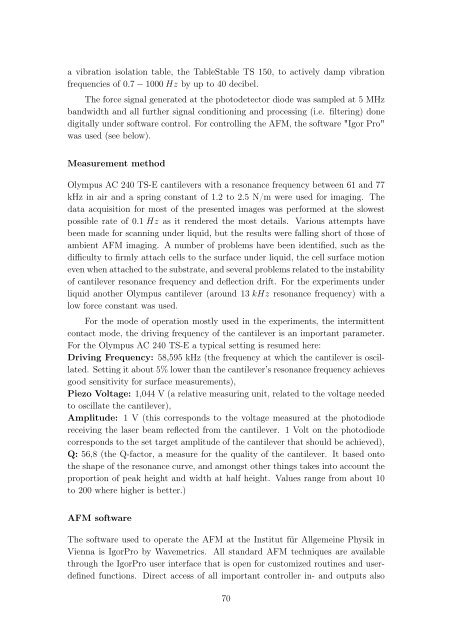Thesis-PDF - IAP/TU Wien
Thesis-PDF - IAP/TU Wien
Thesis-PDF - IAP/TU Wien
Create successful ePaper yourself
Turn your PDF publications into a flip-book with our unique Google optimized e-Paper software.
a vibration isolation table, the TableStable TS 150, to actively damp vibration<br />
frequencies of 0.7 − 1000 Hz by up to 40 decibel.<br />
The force signal generated at the photodetector diode was sampled at 5 MHz<br />
bandwidth and all further signal conditioning and processing (i.e. filtering) done<br />
digitally under software control. For controlling the AFM, the software "Igor Pro"<br />
was used (see below).<br />
Measurement method<br />
Olympus AC 240 TS-E cantilevers with a resonance frequency between 61 and 77<br />
kHz in air and a spring constant of 1.2 to 2.5 N/m were used for imaging. The<br />
data acquisition for most of the presented images was performed at the slowest<br />
possible rate of 0.1 Hz as it rendered the most details. Various attempts have<br />
been made for scanning under liquid, but the results were falling short of those of<br />
ambient AFM imaging. A number of problems have been identified, such as the<br />
difficulty to firmly attach cells to the surface under liquid, the cell surface motion<br />
even when attached to the substrate, and several problems related to the instability<br />
of cantilever resonance frequency and deflection drift. For the experiments under<br />
liquid another Olympus cantilever (around 13 kHz resonance frequency) with a<br />
low force constant was used.<br />
For the mode of operation mostly used in the experiments, the intermittent<br />
contact mode, the driving frequency of the cantilever is an important parameter.<br />
For the Olympus AC 240 TS-E a typical setting is resumed here:<br />
Driving Frequency: 58,595 kHz (the frequency at which the cantilever is oscillated.<br />
Setting it about 5% lower than the cantilever’s resonance frequency achieves<br />
good sensitivity for surface measurements),<br />
Piezo Voltage: 1,044 V (a relative measuring unit, related to the voltage needed<br />
to oscillate the cantilever),<br />
Amplitude: 1 V (this corresponds to the voltage measured at the photodiode<br />
receiving the laser beam reflected from the cantilever. 1 Volt on the photodiode<br />
corresponds to the set target amplitude of the cantilever that should be achieved),<br />
Q: 56,8 (the Q-factor, a measure for the quality of the cantilever. It based onto<br />
the shape of the resonance curve, and amongst other things takes into account the<br />
proportion of peak height and width at half height. Values range from about 10<br />
to 200 where higher is better.)<br />
AFM software<br />
The software used to operate the AFM at the Institut für Allgemeine Physik in<br />
Vienna is IgorPro by Wavemetrics. All standard AFM techniques are available<br />
through the IgorPro user interface that is open for customized routines and userdefined<br />
functions. Direct access of all important controller in- and outputs also<br />
70

















